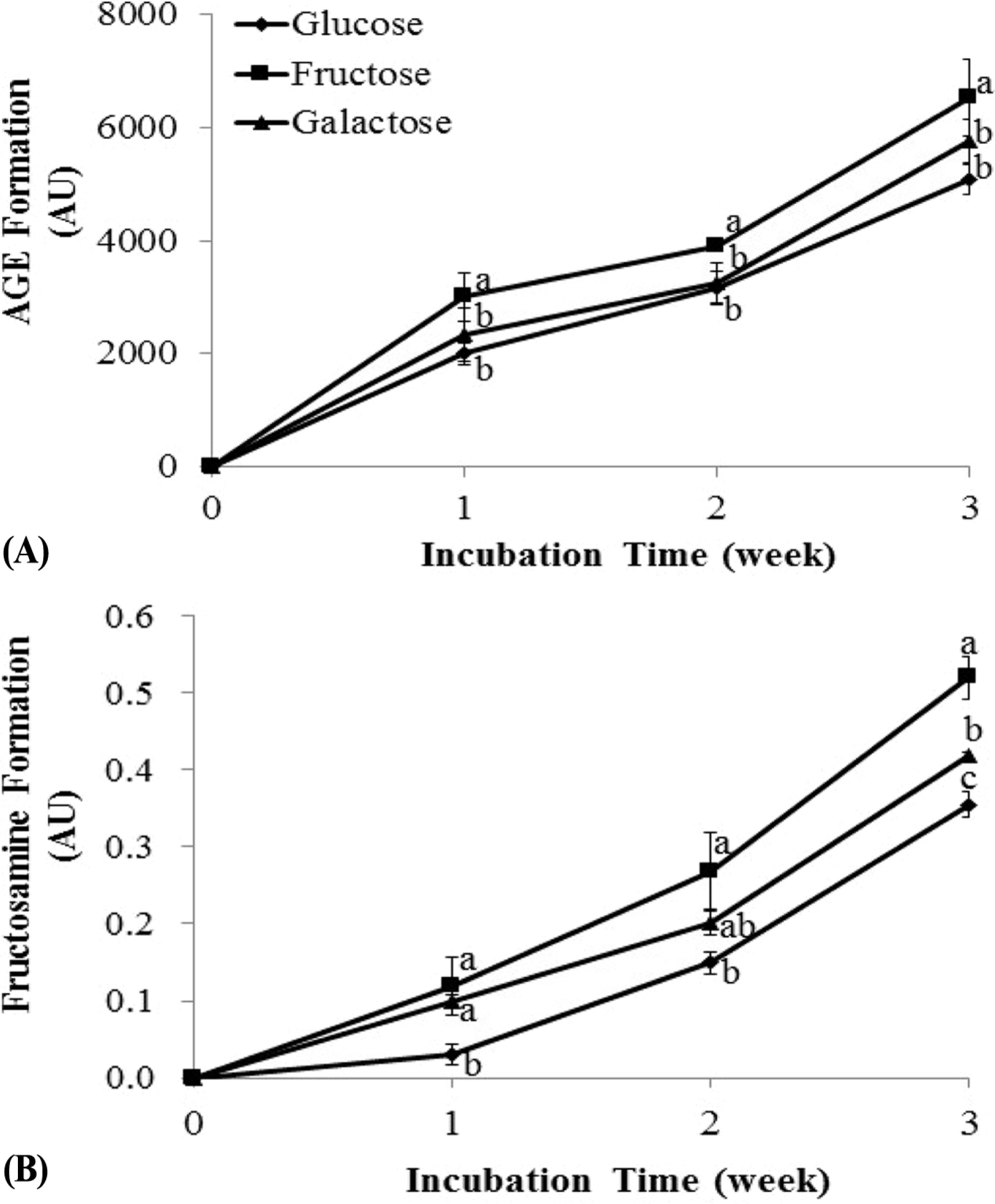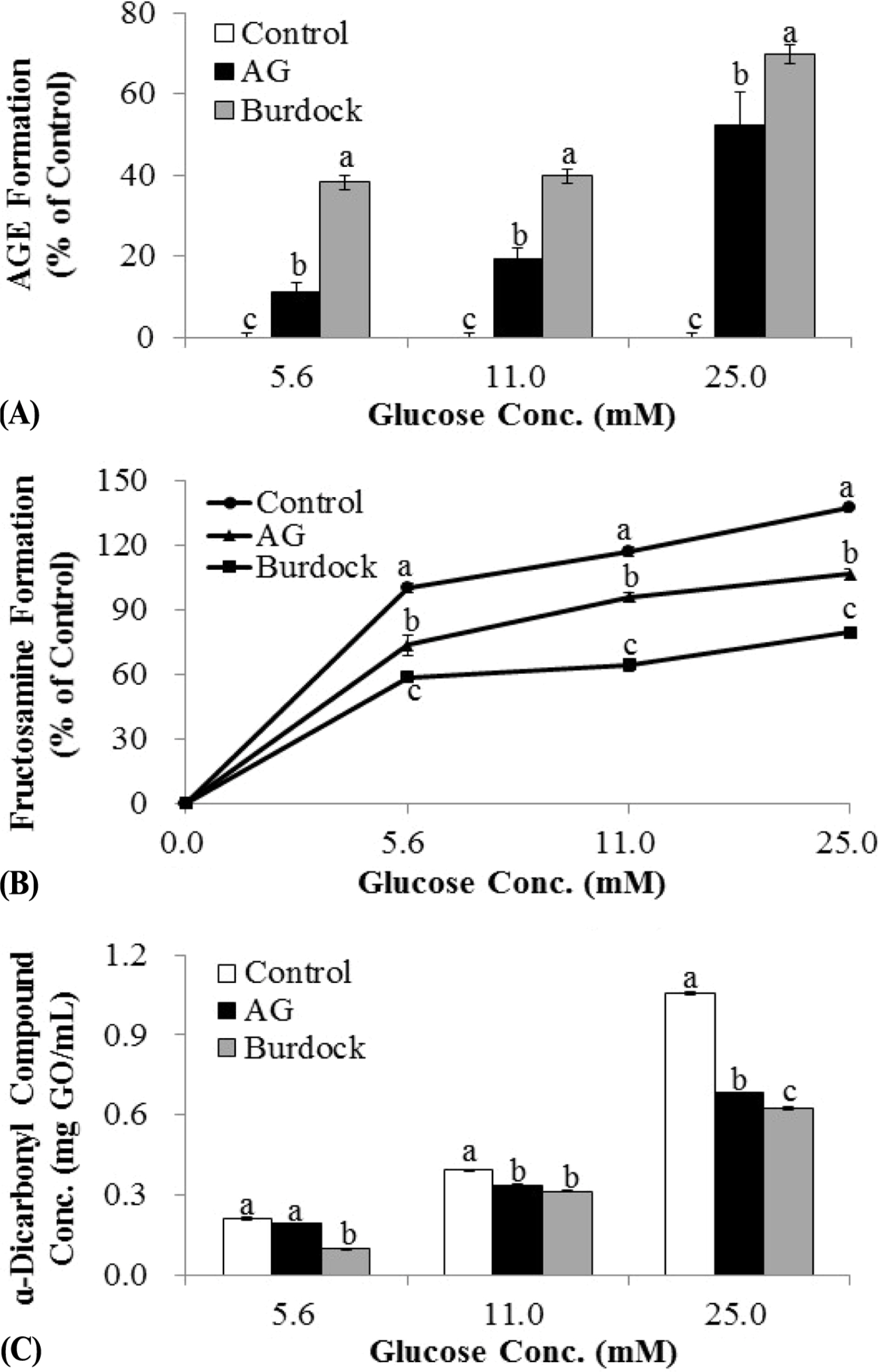J Nutr Health.
2016 Aug;49(4):233-240. 10.4163/jnh.2016.49.4.233.
Inhibition of advanced glycation end product formation by burdock root extract
- Affiliations
-
- 1Department of Food and Nutrition, Yeungnam University, Gyeongbuk 38541, Korea. cykim@yu.ac.kr
- KMID: 2351351
- DOI: http://doi.org/10.4163/jnh.2016.49.4.233
Abstract
- PURPOSE
Diabetic complications are a major concern to manage progression of diabetes. Production of advanced glycation end products (AGEs) due to high blood glucose is one of the mechanisms leading to diabetic complications. Multiple pharmacologic AGE inhibitory agents are currently under development, but clinical applications are still limited due to safety issues. Thus, it is necessary to identify a safe anti-glycation agent. It is known that burdock roots have antioxidant, anti-inflammatory, and anti-cancer activities. The objective of the present study was to investigate the inhibitory role of burdock roots on the formation of high glucose-induced glycation of bovine serum albumin (BSA).
METHODS
In this study, glycation of BSA by glucose, galactose, or fructose at 37℃ for 3 weeks was assessed based on levels of α-dicarbonyl compounds (early-stage glycation products), fructosamine (intermediate products of glycation), and fluorescent AGEs (late-stage glycation products). In order to compare the inhibitory actions of burdock root extract in AGE formation, aminoguanidine (AG), a pharmacological AGE inhibitor, was used as a positive control.
RESULTS
BSA glycation by glucose, fructose, and galatose was dose- and time-dependently produced. Burdock root extract at a concentration of 4 mg/mL almost completely inhibited glucose-induced BSA glycation. The results demonstrate that burdock root extract inhibited AGE formation with an ICâ‚…â‚€ value of 1.534 mg/mL, and inhibitory activity was found to be more effective than the standard anti-glycation agent aminoguanidine. This study identified a novel function of burdock root as a potential anti-glycation agent.
CONCLUSION
Our findings suggest that burdock root could be beneficial for preventing diabetic complications.
Keyword
MeSH Terms
Figure
Reference
-
References
1. Dunkley AJ, Bodicoat DH, Greaves CJ, Russell C, Yates T, Davies MJ, Khunti K. Diabetes prevention in the real world: effectiveness of pragmatic lifestyle interventions for the prevention of type 2 diabetes and of the impact of adherence to guideline recommendations: a systematic review and metaanalysis. Diabetes Care. 2014; 37(4):922–933.2. Guariguata L, Whiting DR, Hambleton I, Beagley J, Linnenkamp U, Shaw JE. Global estimates of diabetes prevalence for 2013 and projections for 2035. Diabetes Res Clin Pract. 2014; 103(2):137–149.
Article3. Jeon JY, Ko SH, Kwon HS, Kim NH, Kim JH, Kim CS, Song KH, Won JC, Lim S, Choi SH, Jang MJ, Kim Y, Oh K, Kim DJ, Cha BY. Taskforce Team of Diabetes Fact Sheet of the Korean Diabetes Association. Prevalence of diabetes and prediabetes according to fasting plasma glucose and HbA1c. Diabetes Metab J. 2013; 37(5):349–357.
Article4. Jeon JY, Kim DJ, Ko SH, Kwon HS, Lim S, Choi SH, Kim CS, An JH, Kim NH, Won JC, Kim JH, Cha BY, Song KH. Taskforce Team of Diabetes Fact Sheet of the Korean Diabetes Association. Current status of glycemic control of patients with diabetes in Korea: the fifth Korea national health and nutrition examination survey. Diabetes Metab J. 2014; 38(3):197–203.
Article5. Bogdanov VY, Østerud B. Cardiovascular complications of diabetes mellitus: the tissue factor perspective. Thromb Res. 2010; 125(2):112–118.
Article6. Fowler MJ. Microvascular and macrovascular complications of diabetes. Clin Diabetes. 2008; 26(2):77–82.
Article7. Adler AI, Stevens RJ, Manley SE, Bilous RW, Cull CA, Holman RR. UKPDS GROUP. Development and progression of nephropathy in type 2 diabetes: the United Kingdom Prospective Diabetes Study (UKPDS 64). Kidney Int. 2003; 63(1):225–232.
Article8. Beckman JA, Creager MA, Libby P. Diabetes and atherosclerosis: epidemiology, pathophysiology, and management. JAMA. 2002; 287(19):2570–2581.9. Almdal T, Scharling H, Jensen JS, Vestergaard H. The independent effect of type 2 diabetes mellitus on ischemic heart disease, stroke, and death: a population-based study of 13,000 men and women with 20 years of follow-up. Arch Intern Med. 2004; 164(13):1422–1426.10. Ceriello A, Testa R. Antioxidant anti-inflammatory treatment in type 2 diabetes. Diabetes Care. 2009; 32(Suppl 2):S232–S236.
Article11. Cooper ME, Bonnet F, Oldfield M, Jandeleit-Dahm K. Mechanisms of diabetic vasculopathy: an overview. Am J Hypertens. 2001; 14(5 Pt 1):475–486.
Article12. Giacco F, Brownlee M. Oxidative stress and diabetic complications. Circ Res. 2010; 107(9):1058–1070.
Article13. Gugliucci A. Glycation as the glucose link to diabetic complications. J Am Osteopath Assoc. 2000; 100(10):621–634.14. Singh VP, Bali A, Singh N, Jaggi AS. Advanced glycation end products and diabetic complications. Korean J Physiol Pharmacol. 2014; 18(1):1–14.
Article15. Baynes JW. The role of AGEs in aging: causation or correlation. Exp Gerontol. 2001; 36(9):1527–1537.
Article16. Vlassara H, Uribarri J. Advanced glycation end products (AGE) and diabetes: cause, effect, or both? Curr Diab Rep. 2014; 14(1):453–464.
Article17. Schleicher E, Friess U. Oxidative stress, AGE, and atherosclerosis. Kidney Int Suppl. 2007; 106:S17–S26.
Article18. Baynes JW. Role of oxidative stress in development of complications in diabetes. Diabetes. 1991; 40(4):405–412.
Article19. Evans JL, Goldfine ID, Maddux BA, Grodsky GM. Oxidative stress and stress-activated signaling pathways: a unifying hypothesis of type 2 diabetes. Endocr Rev. 2002; 23(5):599–622.
Article20. Brownlee M, Vlassara H, Kooney A, Ulrich P, Cerami A. Aminoguanidine prevents diabetes-induced arterial wall protein crosslinking. Science. 1986; 232(4758):1629–1632.
Article21. Thornalley PJ. Use of aminoguanidine (Pimagedine) to prevent the formation of advanced glycation endproducts. Arch Biochem Biophys. 2003; 419(1):31–40.
Article22. Viberti G, Slama G, Pozza G, Czyzyk A, Bilous RW, Gries A, Keen H, Fuller JH, Menzinger G. Steering Committee. Safety Committee. Early closure of European Pimagedine trial. Lancet. 1997; 350(9072):214–215.23. Pari L, Saravanan G. Antidiabetic effect of cogent db, a herbal drug in alloxan-induced diabetes mellitus. Comp Biochem Physiol C Toxicol Pharmacol. 2002; 131(1):19–25.
Article24. Zhao F, Wang L, Liu K. In vitro anti-inflammatory effects of arcti-genin, a lignan from Arctium lappa L., through inhibition on iNOS pathway. J Ethnopharmacol. 2009; 122(3):457–462.
Article25. Maruta Y, Kawabata J, Niki R. Antioxidative caffeoylquinic acid derivatives in the roots of burdock (Arctium lappa L.). J Agric Food Chem. 1995; 43(10):2592–2595.
Article26. Chan YS, Cheng LN, Wu JH, Chan E, Kwan YW, Lee SM, Leung GP, Yu PH, Chan SW. A review of the pharmacological effects of Arctium lappa (burdock). Inflammopharmacology. 2011; 19(5):245–254.
Article27. Kim M, Lee Y, Sohn H. Anti-thrombosis and antioxidative activity of the root of Arctium lappa L. Korean J Food Preserv. 2014; 21(5):727–734.28. de Almeida AB, Luiz-Ferreira A, Cola M, Di Pietro Magri L, Batista LM, de Paiva JA, Trigo JR, Souza-Brito AR. Anti-ulcero-genic mechanisms of the sesquiterpene lactone onopordopicrin-enriched fraction from Arctium lappa L. (Asteraceae): role of somatostatin, gastrin, and endogenous sulfhydryls and nitric oxide. J Med Food. 2012; 15(4):378–383.
Article29. Sugiura Y, Torii T, Matsuda K, Yamada Y. Anti-allergic effects of extracts from commercial products of cooked burdock. Food Sci Technol Res. 2009; 15(4):423–426.
Article30. Wu J, Hsieh C, Wang H, Chen H. Inhibitory effects of guava (Psidium guajava L.) leaf extracts and its active compounds on the glycation process of protein. Food Chem. 2009; 113:78–84.
Article31. Wells-Knecht KJ, Zyzak DV, Litchfield JE, Thorpe SR, Baynes JW. Mechanism of autoxidative glycosylation: identification of glyoxal and arabinose as intermediates in the autoxidative modification of proteins by glucose. Biochemistry. 1995; 34(11):3702–3709.32. Yeboah FK, Alli I, Yaylayan VA. Reactivities of D-glucose and D-fructose during glycation of bovine serum albumin. J Agric Food Chem. 1999; 47(8):3164–3172.
Article33. Münch G, Taneli Y, Schraven E, Schindler U, Schinzel R, Palm D, Riederer P. The cognition-enhancing drug tenilsetam is an inhibitor of protein crosslinking by advanced glycosylation. J Neural Transm Park Dis Dement Sect. 1994; 8(3):193–208.
Article34. Ledesma-Osuna AI, Ramos-Clamont G, Vázquez-Moreno L. Characterization of bovine serum albumin glycated with glucose, galactose and lactose. Acta Biochim Pol. 2008; 55(3):491–497.
Article35. Kontogianni VG, Charisiadis P, Margianni E, Lamari FN, Geroth-anassis IP, Tzakos AG. Olive leaf extracts are a natural source of advanced glycation end product inhibitors. J Med Food. 2013; 16(9):817–822.
Article36. Hori M, Yagi M, Nomoto K, Shimode A, Ogura M, Yonei Y. Inhibition of advanced glycation end product formation by herbal teas and its relation to anti-skin aging. Anti Aging Med. 2012; 9(6):135–148.37. Jariyapamornkoon N, Yibchok-anun S, Adisakwattana S. Inhibition of advanced glycation end products by red grape skin extract and its antioxidant activity. BMC Complement Altern Med. 2013; 13(1):171–179.
Article38. Mesías M, Navarro M, Gökmen V, Morales FJ. Antiglycative effect of fruit and vegetable seed extracts: inhibition of AGE formation and carbonyl-trapping abilities. J Sci Food Agric. 2013; 93(8):2037–2044.
Article39. Predes FS, Ruiz AL, Carvalho JE, Foglio MA, Dolder H. Antioxidative and in vitro antiproliferative activity of Arctium lappa root extracts. BMC Complement Altern Med. 2011; 11(1):25–29.
Article40. Kim J, Jeong IH, Kim CS, Lee YM, Kim JM, Kim JS. Chlorogenic acid inhibits the formation of advanced glycation end products and associated protein crosslinking. Arch Pharm Res. 2011; 34(3):495–500.
Article41. Gugliucci A, Bastos DH, Schulze J, Souza MF. Caffeic and chlorogenic acids in Ilex paraguariensis extracts are the main inhibitors of AGE generation by methylglyoxal in model proteins. Fitoterapia. 2009; 80(6):339–344.
Article
- Full Text Links
- Actions
-
Cited
- CITED
-
- Close
- Share
- Similar articles
-
- Phenolic Compounds from the Leaves of Homonoia riparia and their Inhibitory Effects on Advanced Glycation End Product Formation
- The Role of Advanced Glycation End Products in Diabetic Vascular Complications
- Receptor for Advanced Glycation Endproducts (RAGE), Its Ligands, and Soluble RAGE: Potential Biomarkers for Diagnosis and Therapeutic Targets for Human Renal Diseases
- Effect of Drinking Green Tea on Glycation and Oxidation of Aortic Collagen in Diabetic Rat
- Anti-inflammatory, Anti-glycation, Anti-tyrosinase and CDK4 Inhibitory Activities of Alaternin (=7-Hydroxyemodin)





